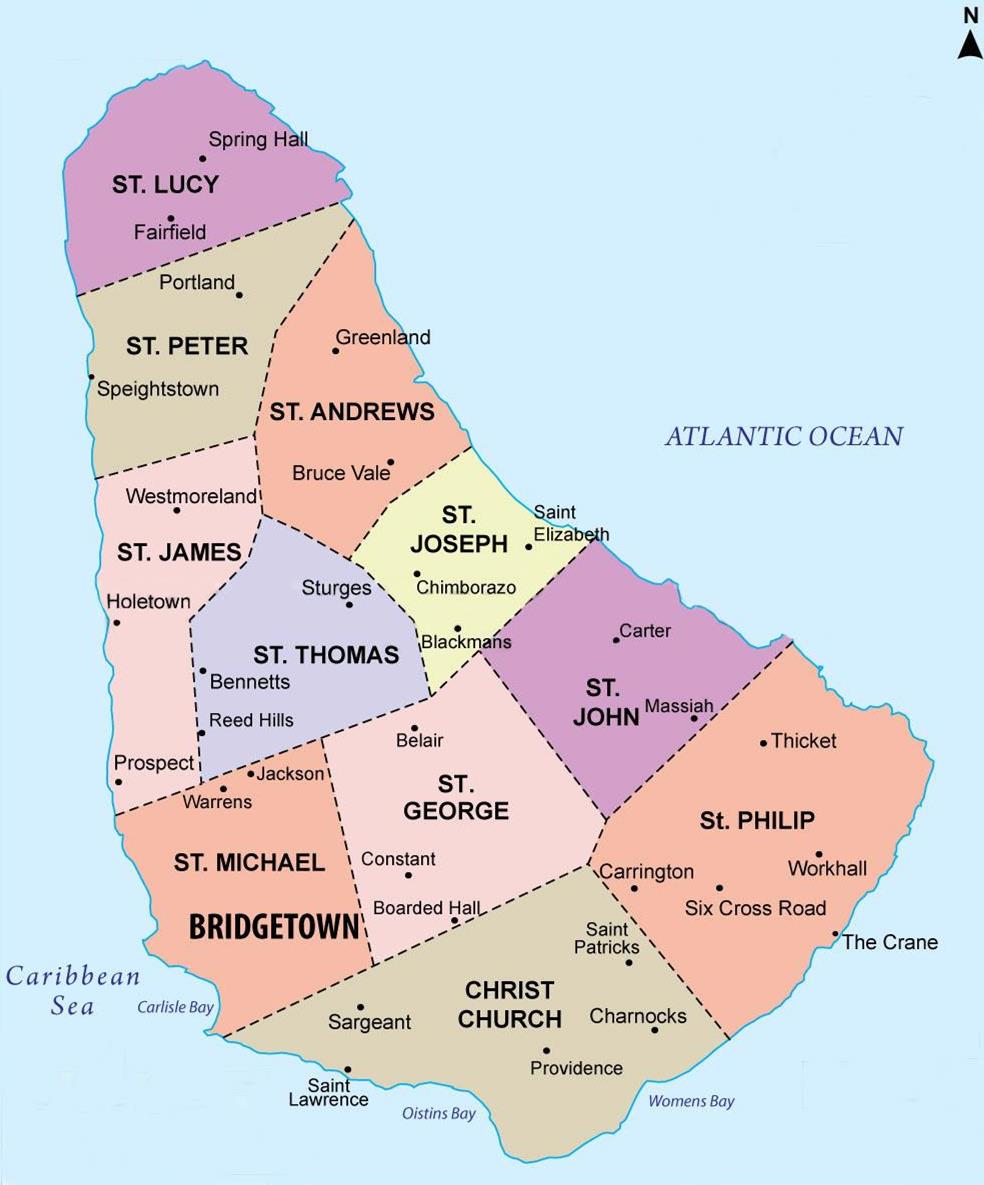 Barbados is not located in the Caribbean sea but rather lies in the Atlantic Ocean, and being the nearest island to Afrika was strategically placed to become the trading hub for the Afrikan slaves as well as the first port of call for the slave ships from the non-Iberian European states.
Barbados is not located in the Caribbean sea but rather lies in the Atlantic Ocean, and being the nearest island to Afrika was strategically placed to become the trading hub for the Afrikan slaves as well as the first port of call for the slave ships from the non-Iberian European states.
Barbados, a former British colony, was known as the Caribbean's most "British" island and was nicknamed "Little England", since British culture was very noticeable throughout the island. Barbadians speak with a slight British accent, play the British sport of cricket, and embrace British conventions in their legal and political affairs.

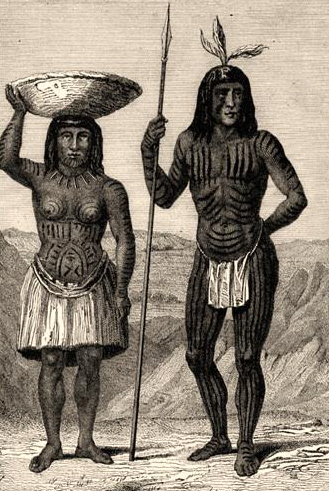
However, Ichirouganaim which means "Big red island with sharp white teeth", was the name given to the island by its earliest inhabitants, the Native American nomads commonly known as Amerindians. They had inhabited the island from as far back as 1623 B.C. or 4000 years ago according to recent archaeological discoveries unearthed at a site at Port St. Charles.
The first migration of Native Americans known as the Saladoid-Barrancoid were made up of farmers, fishermen, and ceramists who arrived from Venezuela, South America, by crossing the Atlantic Ocean in dugout canoes, reaching Barbados around 350 C.E.
The second movement of Amerindians from South America were the Lokono or Arawak who arrived around 800 C.E. The Arawaks (Taino) were a short tribe of agriculturalists who grew cotton, cassava, guavas, corn, papaws, and peanuts. They also used harpoons, nets, and hooks to fish.
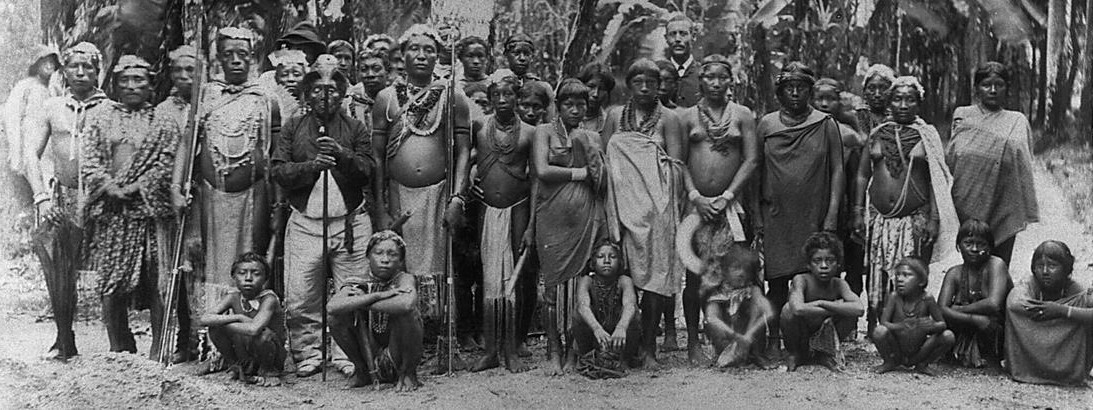
An arawak tribe, the first tribal people that Christopher Columbus would have encountered in the Caribbean.
The third wave of migrants also from South America were the Caribs (Kalingo) who were a taller and more violent Amerindian tribe than the Arawaks The Spanish called this tribe "Caribes" (Caribs) which means cannibals, the word from which the region derived its name Caribbean.
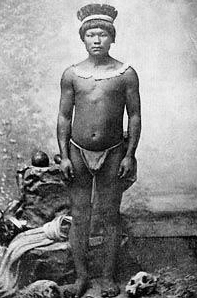
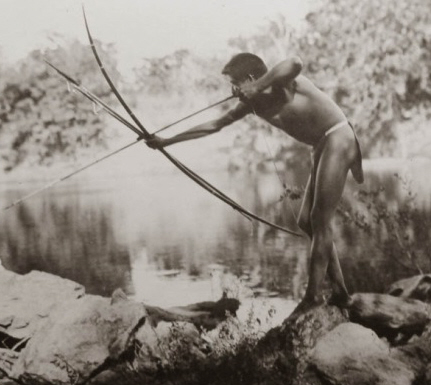 The Caribs were extremely accurate bowmen who used potent venom to paralyze their victims. They were a warlike tribe who were said to have barbecued their captives and washed them down with cassava beer.
The Caribs were extremely accurate bowmen who used potent venom to paralyze their victims. They were a warlike tribe who were said to have barbecued their captives and washed them down with cassava beer.
Textbooks still continue to promote this legend of Carib cannibalism, but in fact human flesh was not actually eaten as food, but was used as a ritual practice to gain control over the dead enemies' or ancestors' qualities. This ritual was usually performed prior to a raiding mission or during an induction when it was decided that young men would take over the spirit of an illustrious warrior.
The Arawaks were a peace-loving tribe who lived on one side of the island, whereas the warlike Caribs inhabited the other side.
By 1200 A.D. both the Arawak and the Salodoid-Barrancoid inhabitants were displaced by the warrior type Carib Indians, whose control lasted for about 300 years until that peaceful livelihood was abruptly brought to an end by the Spanish conquistadors in 1492, who claimed Barbudos for Spain. They began abducting and enslaving the Amerindian tribes from the Caribbean islands, forcing them to work on plantations in the region.
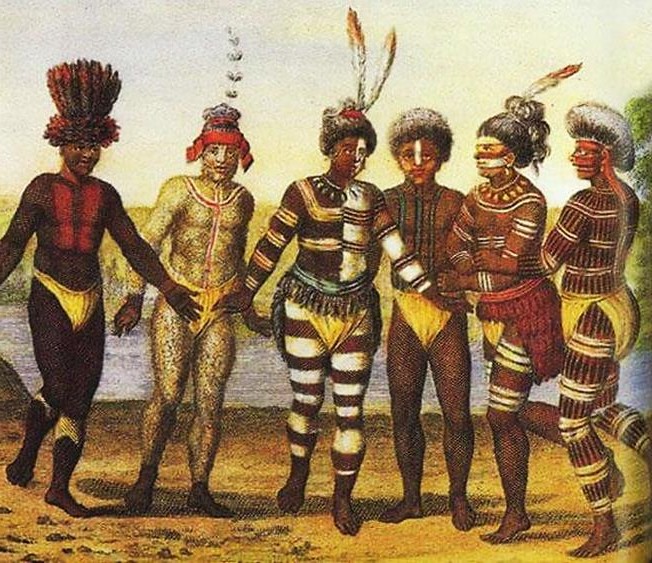
This is an early painting of the Taino and Arawak people shown with dark skin and kinky hair.

King Ferdinand of Spain identified Barbudos among a group of islands where all Caribs were ordered to be captured and enslaved because of their resistance to Christianity. The crown legalized war against the Caribs of Barbudos and the Lesser Antilles, making it legal for them to be captured, shipped to and enslaved in Hispaniola and Puerto Rico. Also, as per a royal decree issued in July, 1511, all Caribs introduced as slaves were to be branded with an “F” on either their legs or arms to identify them as the property of King Ferdinand.
King Ferdinand also released a decree in December 1511, for the abduction of Amerindian slaves from Barbados. The Igneri-Arawaks were the main tribe captured by Spanish slave raiding ships and consigned to Hispaniola where they were worked to death. In 1518, King Charles V of Spain wrote to Judge Rodrigo de Figueroa who was sent to Hispaniola with instructions that any Igneri-Arawaks taken from Barbados should be treated like the native Taino-Arawaks there. A Ruttiers publication announced in 1585 that the Dutch slave traders had captured the remaining Igneri-Arawaks found on Barbados to start the Guiana community.
The name Barbudos first appeared on ancient Spanish maps on December 23, 1511, where King Ferdinand of Spain referred to it as “Los Barbudos” (The bearded men).
In the Spanish language, the singular form "el barbado" means “the bearded man”, while the plural form "los barbados" mean “the bearded men”. Similarly, the variation "el barbudo" also means “the bearded man”, and "los barbudos" mean “the bearded men”, hence the name "Barbados or Barbudos".
The island got its Spanish name “Barbudos / Barbados” or “the bearded men” because of the earlier Afrikan explorers who were bearded men or their offspring through unions with the Amerindians.
Note that there were two types of Indians. The Negroid Phenotype Indian (left), and The Mongoloid Phenotype Indian (right). However, the media only promotes the latter class which is commonly seen in movies and books, completely ignoring the Negroid group, thus creating the false impression that there was only one type of indian.
By 1518, The Spanish crown had ordered Rodrigo de Figueroa, a Spanish colonial Judge, to identify those parts of the region that were populated by Caribs. He reported that Carib Indians were taken from “Los Barbudos”, after which time the island was deemed to be non-Carib. The Caribs had fled the island and relocated to other nearby islands in order to escape:
- Enslavement,
- Famine,
- Previously unknown contagious diseases like small pox and tuberculosis introduced by the European,
- Being abducted by the Spanish and taken to larger islands like Hispaniola and Puerto Rico to work in gold mines and plantations as slave labourers.
By 1536 Barbados had become a deserted island since the slave traders had depopulated it, while the remaining inhabitants had fled to nearby mountainous islands for safety. This combination of events left the island uninhabited until the arrival of the first British ship in 1625.
TThe official archives of the Antillean Indians confirmed that the Colombian expeditions had stumbled upon the islands including the group of Antillean islands at a much earlier period, laying claim to them for the crown of Spain, and those expeditions had preceded the explorations of Pedro a Campos in 1536 and the subsequent voyages which arrived later that came to plunder, destroy and raid for spoils.

 Pedro a Campos, who is widely believed to have given the island the name “Os Barbados” when the Portuguese stopped by in 1536 en route to Brazil, chose not to stay but left some wild pigs behind for breeding purposes which greeted the first British colonizers. It is also commonly believed that the name “Os Barbados” was given because of the Iberians' fascination with the hanging aerial roots of the Bearded Fig Tree [left], which seemed to resemble long, thick beards.
Pedro a Campos, who is widely believed to have given the island the name “Os Barbados” when the Portuguese stopped by in 1536 en route to Brazil, chose not to stay but left some wild pigs behind for breeding purposes which greeted the first British colonizers. It is also commonly believed that the name “Os Barbados” was given because of the Iberians' fascination with the hanging aerial roots of the Bearded Fig Tree [left], which seemed to resemble long, thick beards.
In Portuguese “barba” means “beard” and “barbados” means “the bearded ones”. However, prior to the Portuguese stopping by, Barbados had already acquired the Spanish name “Los Barbados”. This suggests that it was not named after any bearded fig trees sighted on the island, but after the bearded Afrikan forerunners and their offspring who inhabited the island.
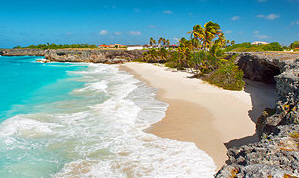 Barbados remained uninhabited for 100 years until 1625, when a crew from an English ship called the Olive Blossom which had been blown off course while sailing from the Guianas, landed at an inlet which the captain, Henry Powell, christened The Hole, now Holetown.
Barbados remained uninhabited for 100 years until 1625, when a crew from an English ship called the Olive Blossom which had been blown off course while sailing from the Guianas, landed at an inlet which the captain, Henry Powell, christened The Hole, now Holetown.
After verifying that it was deserted, he took possession of the island in the name of King James 1st for the Crown of England. A cross was erected, and on a nearby tree “James K. of E. and of this island” was inscribed. He returned to England and formalized a plan to introduce a permanent colony on the island.

Barbados was later settled in 1627 by Sir William Courteen a London merchant, who provided the funds to establish a settlement that started with a group of 40 British colonists (or 80 by some accounts).
Slavery soon got started when Captain Powell brought in the first group of 8 enslaved Afrikans who came from the Elmina and Axim Slave Forts located along the Gold Coast (Ghana), aboard the British ship William and John.
Nigerians were also forcibly abducted from the Badagry Slave Fort and sold to Barbados by the English European Slave traders.
The slave trade was of great benefit to Barbados because of its geographical location and the favourable trade winds. Close to 123,400 captured Afrikans, who made up a significant portion of the island’s enslaved population, were shipped to Barbados from the Gold Coast ports.
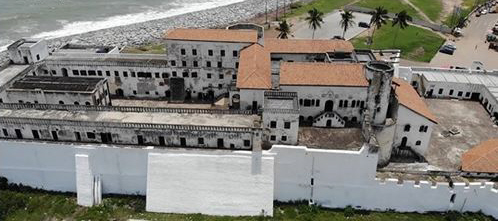
The Elmina Slave Dungeon - Point of no return - Gold Coast (Ghana).
Bridgetown, the capital of Barbados, became the commercial centre, and by the 17th century it was the focus of the British trade expansion in the Americas. Bridgetown was converted into a trading post or hub for the shipment of sugar and other commodities to England and other ports, in addition to the re-exportation of enslaved Afrikans for distribution throughout other Caribbean islands, the Americas, and Venezuela.
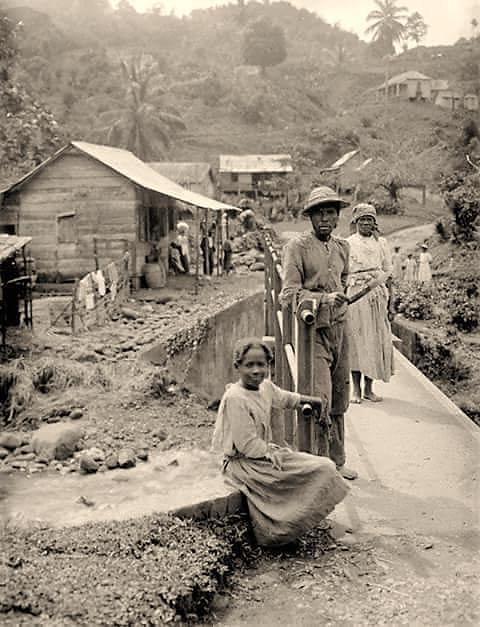 By the mid-seventeenth century Barbados was a leading participant in the slave trade and one of the most profitable European colonies in the world. In 1645, there were an estimated 5,680 Afrikan slaves in Barbados, by 1667 there were more than 40,000, and by 1685, the numbers had grown to around 60,000. In 1700 it was estimated that there were about 135,000 Afrikan-born slaves in Barbados.
By the mid-seventeenth century Barbados was a leading participant in the slave trade and one of the most profitable European colonies in the world. In 1645, there were an estimated 5,680 Afrikan slaves in Barbados, by 1667 there were more than 40,000, and by 1685, the numbers had grown to around 60,000. In 1700 it was estimated that there were about 135,000 Afrikan-born slaves in Barbados.
After the War of Spanish Succession, England was given the authority to export slaves from their possessions in the Caribbean. The Royal Afrikan Company then established offices in Barbados and Jamaica where slaves were re-exported to Mexico from the Jamaica office and to Venezuela from Barbados.
In 1627 the English colonisers in Barbados began to face starvation, so John Powell set sail from Barbados to the Dutch settlement in Guyana for assistance, where the Dutch Captain Adrian Groenewegen helped him with a shipment of cassava and other food supplies.

40 Igneri-Arawaks were also sent to Barbados from the Dutch settlement in Guyana, whose task was to educate the English colonizers for one year in survival techniques and how to plant cassava, other root crops, and tobacco, since they possessed knowledge of the local foods and how to prepare them, thus saving the lives of those English settlers. They also knew the most effective ways to clear dense tropical forest for the construction of colonial buildings and residences. The chiefs from these 40 Igneri-Arawaks revealed to Captain Powell that their ancestors had previously been living in Barbados before they were taken to Guyana by the Dutch against their will.
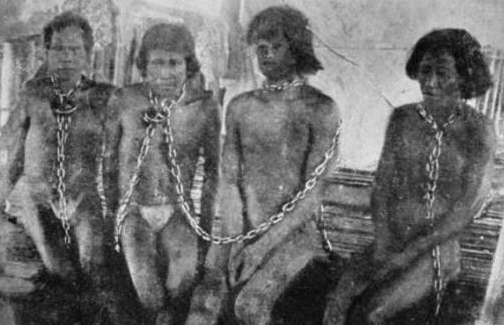 In 1628, James Hay, the Earl of Carlisle who had secured patents from King Charles 1st of England for Barbados, had sent Captain Wolverstone to Barbados with 64 men who wasted no time in paying back the kindness of the Igneri-Arawaks who were tutoring the colonizers, by enslaving them.
In 1628, James Hay, the Earl of Carlisle who had secured patents from King Charles 1st of England for Barbados, had sent Captain Wolverstone to Barbados with 64 men who wasted no time in paying back the kindness of the Igneri-Arawaks who were tutoring the colonizers, by enslaving them.
Fortunately, one Arawak escaped and went back to Guyana where he related what had happened to his tribe. This created great anger among the Lokono-Arawaks, a branch of the Igneri tribe, causing them to make threats to kill every Dutch person in Guyana if the remaining 39 Igneri-Arawaks abducted in Barbados were not released and returned to Guyana. As a result, the Dutch Governor decided to marry the daughter of a powerful Kalina-Carib Chief in Guyana so as to obtain the protection of the tribe. However, he was still required to pay the English colonists in Barbados a bribe to have the Igneri-Arawaks returned safely.
 Sir William Courteen lost his title to the Earl of Carlisle in what was known as the "Great Barbados Robbery". Carlisle chose Henry Hawley as governor who then laid the foundation for the first parliament or House of Assembly in 1639, which, along with a nominated advisory Council and the Governor of the island, ruled in partnership with the Anglican Church, (the state sanctioned religion). They established the third oldest parliament in the world behind the British House of Commons, and the Bermuda House of Assembly.
Sir William Courteen lost his title to the Earl of Carlisle in what was known as the "Great Barbados Robbery". Carlisle chose Henry Hawley as governor who then laid the foundation for the first parliament or House of Assembly in 1639, which, along with a nominated advisory Council and the Governor of the island, ruled in partnership with the Anglican Church, (the state sanctioned religion). They established the third oldest parliament in the world behind the British House of Commons, and the Bermuda House of Assembly.
 As the Barbados' House of Assembly was always very loyal to the British crown, when Charles 1st was executed in 1649, Barbados declined to accept the leadership of Oliver Cromwell, who in 1650 dispatched a fleet of 7 ships mounted with 236 guns under the command of Sir George Ayscue, to seize control of Barbados and compel the island and other English plantations to submit to the commonwealth. However, for months after his arrival, Cromwell could do little but blockade the island as he was driven back at the Carlisle blockhouse when he attempted to land, losing 15 men in the process, but he eventually succeeded in docking further to the north of the island at Speightstown. The settlers kept his forces at bay during six months of heavy resistance, until he was forced to yield and sign the Articles of Agreement on January 11th 1652 in Oistins town, Christ Church, which were accepted as the Charter of Barbados by the Parliament in England.
As the Barbados' House of Assembly was always very loyal to the British crown, when Charles 1st was executed in 1649, Barbados declined to accept the leadership of Oliver Cromwell, who in 1650 dispatched a fleet of 7 ships mounted with 236 guns under the command of Sir George Ayscue, to seize control of Barbados and compel the island and other English plantations to submit to the commonwealth. However, for months after his arrival, Cromwell could do little but blockade the island as he was driven back at the Carlisle blockhouse when he attempted to land, losing 15 men in the process, but he eventually succeeded in docking further to the north of the island at Speightstown. The settlers kept his forces at bay during six months of heavy resistance, until he was forced to yield and sign the Articles of Agreement on January 11th 1652 in Oistins town, Christ Church, which were accepted as the Charter of Barbados by the Parliament in England.
On April 30, 1655, the Dutch Admiral De Ruyter attacked Barbados with a fleet of 12 line of battle ships, 2 fire ships and several small vessels carrying 2,500 men on board, but this attempt failed and De Ruyter’s own ship The Mirror was disabled by the fire power from Charles Fort and other ports at Carlisle Bay.

The Civil War at the time of Charles 1st helped to populate the island since many Royalist families found refuge on the island. Barbados became a destination for military prisoners and Irish natives in the early years of the colony's growth. Cromwell exploited the island as a place of exile for Scotch and Irish prisoners of war, as well as for rebellious men. He also "barbadosed" any Irish who refused to clear their land, and allowed for other Irish to be kidnapped from the streets of Ireland for shipment to Barbados as slaves. Many West Country men were also exiled or "barbadosed" by Judge Jeffreys as slaves to British planters, where they lived in slave conditions with no control over the number of years they had to serve.
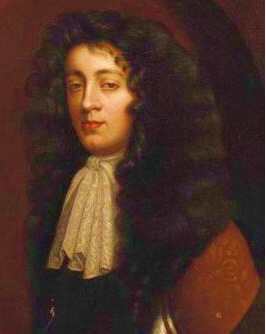 By 1667 Barbados became such a strategic and well known centre for Amerindian slavery in the Caribbean, that according to Forbes, the term “to Barbadoes” someone was synonymous with being kidnapped and deported to the Caribbean.
By 1667 Barbados became such a strategic and well known centre for Amerindian slavery in the Caribbean, that according to Forbes, the term “to Barbadoes” someone was synonymous with being kidnapped and deported to the Caribbean.
James 2nd and George 2nd later used Barbados to get rid of the Monmouth rebels and followers of Prince Charles, since the rebel James Scott, 1st Duke of Monmouth, attempted to seize the English throne from his uncle the Duke of York who had become King of England, Scotland, and Ireland upon the death of his older brother Charles 2nd on February 6th 1685.
The first set of slaves imported into the American colonies consisted of 100 white children who arrived in 1619, or four months prior to the landing of the first consignment of Black slaves.
The Irish slave trade was set into motion when James 2nd sold 30,000 Irish prisoners as slaves to the New World. A decree issued in 1625 mandated that Irish political prisoners be transported overseas and sold to English settlers in the West Indies.
Barbados became a destination for military prisoners and Irish natives in the early years of the colony's growth. The estimated number of "barbadosed" Irish varied from as low as 12,000 to as high as 60,000. Persecuted Catholics from Ireland also worked on the plantations.
 Over 100,000 Irish children between the ages of 10 and 14 were taken from their parents and sold as slaves in the West Indies, Virginia and New England during the 1650s. 52,000 Irish made up of women and children were sold to Barbados and Virginia. None of the Irish victims ever made it back to their homeland to relate the stories of their suffering.
Over 100,000 Irish children between the ages of 10 and 14 were taken from their parents and sold as slaves in the West Indies, Virginia and New England during the 1650s. 52,000 Irish made up of women and children were sold to Barbados and Virginia. None of the Irish victims ever made it back to their homeland to relate the stories of their suffering.
 Ireland rapidly became the biggest supplier of human cattle for English merchants, and Barbados quickly acquired the largest white population of any of the English colonies in the Americas, becoming the springboard for English colonisation in the Americas. Barbados not only became the most populated of England's overseas colonies, but also one of the most heavily populated colonies in the world. Barbados also played a leading role in the settlement of Jamaica and the Carolinas.
Ireland rapidly became the biggest supplier of human cattle for English merchants, and Barbados quickly acquired the largest white population of any of the English colonies in the Americas, becoming the springboard for English colonisation in the Americas. Barbados not only became the most populated of England's overseas colonies, but also one of the most heavily populated colonies in the world. Barbados also played a leading role in the settlement of Jamaica and the Carolinas.
European slaves were the main source of labour during most of the island's history, as poor uneducated labourers were recruited in England, Scotland and Europe to work on the tobacco and cotton plantations. Under the law, these bondservants could not be enslaved but were deemed "tenants at will". They were not permitted to own the land they cultivated or to leave the plantation without permission from their employer. The harsh conditions of this type of servitude gradually made it more difficult for Barbadian tobacco and cotton planters to recruit white labour, hence causing the labour supply to dwindle and the ability of the island's tobacco and cotton producers to compete with their international competitors, to collapse.
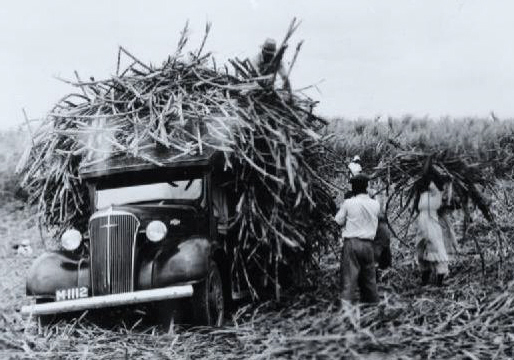 The cultivation of tobacco, cotton, ginger and indigo were handled primarily by European indentured labour until the start of the sugar cane industry in the 1640s, which was introduced by Pieter Blower. Enslaved Afrikans worked on the Sugar plantations established on the Island until 1834 when Slavery was abolished.
As sugar developed into the main commercial enterprise, Barbados was divided into large plantation estates that soon replaced the smaller holdings of the early British settlers. The type of weather and soil conditions in Barbados provided the perfect growing conditions for a flourishing sugar industry, and out of this economic experience the Barbados society was created during the mid-1640s, with the changeover to large-scale production and exportation to England.
The cultivation of tobacco, cotton, ginger and indigo were handled primarily by European indentured labour until the start of the sugar cane industry in the 1640s, which was introduced by Pieter Blower. Enslaved Afrikans worked on the Sugar plantations established on the Island until 1834 when Slavery was abolished.
As sugar developed into the main commercial enterprise, Barbados was divided into large plantation estates that soon replaced the smaller holdings of the early British settlers. The type of weather and soil conditions in Barbados provided the perfect growing conditions for a flourishing sugar industry, and out of this economic experience the Barbados society was created during the mid-1640s, with the changeover to large-scale production and exportation to England.

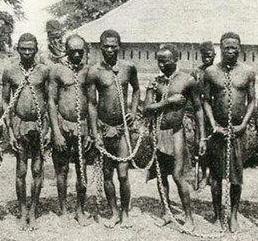 However, the disappearance of the Carib population combined with the skyrocketing cost of white labour in England meant that external labour had to be imported to work on the increasing number of sugar plantations. Therefore, on the advice of Dutch and Sephardic Jewish merchants, planters turned their attention to West Afrika for their source of manpower.
The Gambia River, which stretches from the Atlantic to Afrika, was a key sea route for the slave trade, and at its peak, almost one out of every six West Afrikans came from that region.
However, the disappearance of the Carib population combined with the skyrocketing cost of white labour in England meant that external labour had to be imported to work on the increasing number of sugar plantations. Therefore, on the advice of Dutch and Sephardic Jewish merchants, planters turned their attention to West Afrika for their source of manpower.
The Gambia River, which stretches from the Atlantic to Afrika, was a key sea route for the slave trade, and at its peak, almost one out of every six West Afrikans came from that region.
Tribal ethnic groups from the Gold Coast, Ghana were imported in huge numbers into Barbados as slaves, with the Akan, Asante or Ashanti, Ahanta, Fante or Mfantsefo, and Ga-Adangme tribes providing the bulk of those importations. Afrikans from the Bight of Biafra, Nigeria also supplied slaves to Barbados with the Igbo, Yoruba, Hausa, Fulani, Efik, and Ibibio being the major ethnic clans targeted. Benin-Togo also supplied natives from the Fon, Ewe, Aja and Mina tribes. The Congo likewise provided Afrikans from the Kikongo tribe, and Cameroon provided Afrikans from the Bamileke and Tikar tribes.
The Ivory Coast, Sierra Leone, Guinea, Senegambia and other indigenous tribes from across West Afrika also supplied human cargo to Barbados.
Senegambia is the area covering the Senegal and Gambia Rivers which includes the lands in between such as Senegal, The Gambia, Guinea, Guinea-Bissau, Mali, and West-Central Afrika which includes Angola, Mozambique, the Democratic Republic of Congo and Gabon.
During the days of slavery and colonialism, these different Afrikan tribes intermarried among themselves and with the white English slave masters.
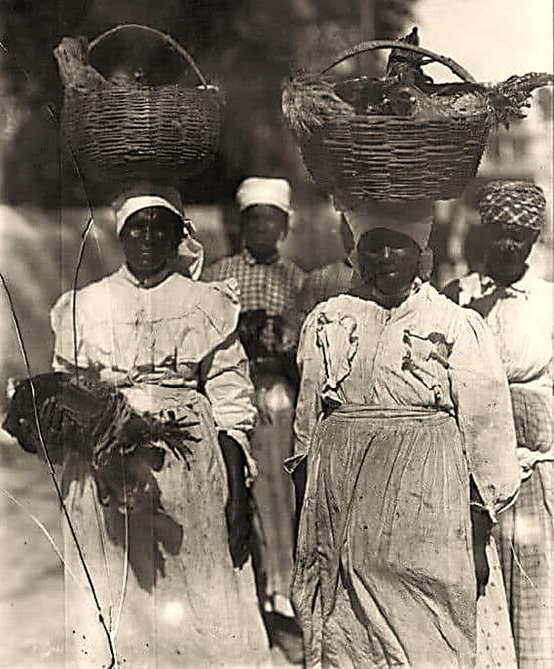 By the mid -1600s there were over 5,000 enslaved Afrikans in Barbados, and by the 1680s there were close to15,000 freed Afrikans with 50,000 still enslaved. During the 1700s, Barbados was regarded as one of the leaders in the Slave trade from the European Territories, playing a vital role in the early buying and selling of Afrikans, which connected the Caribbean to West Afrika and England. Estimates indicate that between 1627 and 1807, approximately 387,000 Afrikans were captured and shipped to Barbados against their will by the English. Over time, many of these enslaved Afrikans were re-exported to other slave owning territories in the Caribbean (West Indies) and in North America.
By the mid -1600s there were over 5,000 enslaved Afrikans in Barbados, and by the 1680s there were close to15,000 freed Afrikans with 50,000 still enslaved. During the 1700s, Barbados was regarded as one of the leaders in the Slave trade from the European Territories, playing a vital role in the early buying and selling of Afrikans, which connected the Caribbean to West Afrika and England. Estimates indicate that between 1627 and 1807, approximately 387,000 Afrikans were captured and shipped to Barbados against their will by the English. Over time, many of these enslaved Afrikans were re-exported to other slave owning territories in the Caribbean (West Indies) and in North America.
Most of the captured Afrikans shipped to Barbados originated from the Bight of Biafra (62,000), the Gold Coast – Ghana (59,000), and the Bight of Benin (45,000). Other Afrikans came from Central Afrika (29,000), Senegambia (14,000), the Windward Coast (13,000), and Sierra Leone (9,000).
The Bight of Biafra (also the Bight of Bonny) located near indigenous Igbo territory, was the main area from where the Igbos, one of the main ethnic groups targeted for enslavement, were captured, shackled, and sold into slavery. The main slave trading ports were situated in Biafra (Bight of Bonny) and Calabar, where an estimated 15% of the Afrikans were abducted, the third highest percentage during the period of the transatlantic slave trade. 1.4 million Igbos were estimated to have been transported across the Atlantic by way of European ships during the era of the Trans-Atlantic slave trade, and were scattered throughout various territories such as Barbados, Jamaica, Cuba, Haiti, Belize, and the United States among other places. Elements of Igbo culture can still be seen in these locations.
 Approximately 20 million Afrikan slaves were jammed into overcrowded, filthy European ships heading to colonial plantations all over the world, making the Middle Passage a synonym for diabolical savagery.
The slaves in Barbados were forced to work on sugar plantations cutting and processing sugar cane in conditions of severe heat while being subjected to cruel and inhumane treatment, but one of the most physically demanding aspects of sugar production was the grinding of the sugar cane by hand which the slaves were forced to do. Barbados became one of England's most popular colonies with a rich economy based on sugar and slavery.
Approximately 20 million Afrikan slaves were jammed into overcrowded, filthy European ships heading to colonial plantations all over the world, making the Middle Passage a synonym for diabolical savagery.
The slaves in Barbados were forced to work on sugar plantations cutting and processing sugar cane in conditions of severe heat while being subjected to cruel and inhumane treatment, but one of the most physically demanding aspects of sugar production was the grinding of the sugar cane by hand which the slaves were forced to do. Barbados became one of England's most popular colonies with a rich economy based on sugar and slavery.
In 1655 Oliver Cromwell declared war against Spain. A squadron of 30 sails under the command of Admiral Penn and General Venables arrived in Barbados with 3,000 men on board. They were reinforced by a troop of horses, a force of 1,000 Leeward islanders, and 2,811 Barbadians all assembled on the island. This force attacked and conquered Jamaica which has since remained a British colony. It is estimated that Barbados had delivered a third of all Jamaican slaves up to 1674, and about a fourth for the remainder of the 17th century.
St. Kitts was the first English colony in the Leeward group of islands where most of the other Leeward Islands were settled with the partial exception of Antigua, which received a great number of immigrants from Barbados and Suriname. Suriname was first permanently settled in 1650 by settlers from Barbados and the Leeward Islands.
Colonial officials passed a law in 1636 that formalized the status of the Afrikan and Amerindian slaves including their offspring, as the property of white settlers. This law stated that all slaves brought to Barbados, both Afrikan and Amerindian must be enslaved for life. As a consequence, Barbados became a nation of masters and slaves with a minority of Jews, poor whites and freed coloureds. Between 1627 and 1838 a colonial structure was developed based on race and wealth with the economy tied to England, whose impact shaped the islands' society and culture.
As the resident white land-owning classes or elites expanded, it brought an awareness of the need for facilities, as schools for children, reading rooms, a press, and other social facilities were made available, creating an infrastructure that was more developed than in the other islands, which prompted General Haynes, a planter, to write, “tis to me the first country in the world”.
The Black population also developed qualities that were different to those in the other islands, since from the beginning of the 18th century, the majority of Black Barbadians were born locally. This large proportion of locally born Blacks of Afrikan descent as opposed to imported Afrikans, contributed greatly to the early development of the Barbadian identity.
There was also an excess of women over men in both racial groups, a pattern which surfaced in the last decades of the 17th century that made Barbados different to the other Caribbean islands where the reverse was the case in both racial groups.
This development allowed the Black population to easily reproduce itself during the second half of the 18th century rather than having to rely heavily on new imports from Afrika to sustain the population levels. This was a reversal of what was taking place on other English speaking Caribbean islands, where the death rate surpassed the birth rate, and forecasts indicated that without continued imports, the slave population would have died out.
As the Afrikan population continued to grow in Barbados, it facilitated the process of forming a new mixed language that saw West Afrikan and European cultural patterns acting on each other to produce a Barbadian version of a wider Caribbean culture. Travellers to the island observed these changes in the 18th century on the white population, who were said to be "lisping the language of the Negroes", or "adopting the Negro style".
Around the beginning of the 18th century, the white bondservants, who were the prime source of labour, began to leave Barbados in droves, questioning their future status on the island. Over 30,000 whites migrated to neighbouring islands, which left a racial imbalance that placed the colony's white plantation owners in a weak position. The growing size of the slave labour force with its possibility for rebellion terrified them, but since they were very dependent on the cheap and supposedly infinite stock of Afrikan slaves, the colonial officials set about to establish a white supremacy prototype to counter that racial imbalance.
The Church of England was especially guilty of the institutional hypocrisy that was widespread at the time, preaching a gospel to save the souls of all mankind, yet turning a blind eye to the planters' profiteering from the brutality of the slave system, so it could continue accessing the needed financial aid to maintain the churches and clergy.

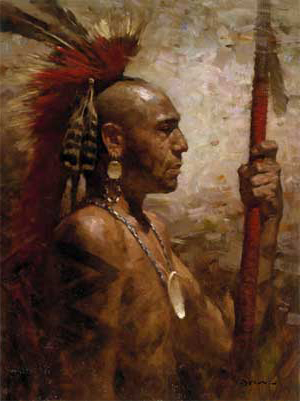
 During the war of 1637 against the Pequot tribe of North America, orders were given to execute all Pequot men but take the women and children as prisoners for auctioning in Barbados and other English colonies. Many were burnt alive, and those Pequots who survived the war were enslaved and forced to abandon their Pequot names. The Pequot River was renamed the Thames, and the town of Pequot was changed to New London. On the right is Sassacus chief Sachem, the feared leader of the Pequot.
During the war of 1637 against the Pequot tribe of North America, orders were given to execute all Pequot men but take the women and children as prisoners for auctioning in Barbados and other English colonies. Many were burnt alive, and those Pequots who survived the war were enslaved and forced to abandon their Pequot names. The Pequot River was renamed the Thames, and the town of Pequot was changed to New London. On the right is Sassacus chief Sachem, the feared leader of the Pequot.
The mass murder of the Pequot in 1637 was the most brutal massacre in ethnic cleansing, where white Americans slaughtered about 900 Pequots while burning down Mystic, their main town in what is now Connecticut, and butchering anyone who attempted to run away. In that year the governor of Massachusetts Bay Colony proclaimed, “This day forth shall be a day of celebration and thanksgiving for subduing the Pequots”, in other words, the purpose of Thanksgiving Day is to observe this Pequot Massacre.
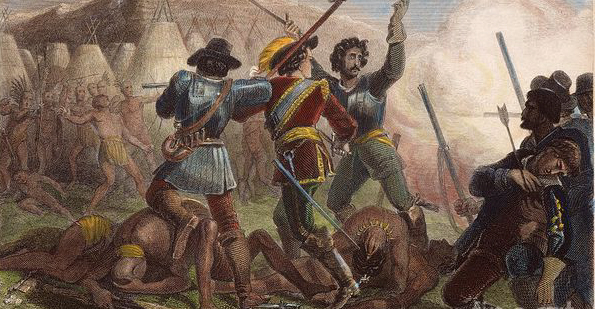 The almost white skinned Susquehannock Indians were extradited to Barbados, Bequia and Bimini during that year. From this identification it is believed that the name “Ecky-Beckies” originated.
The almost white skinned Susquehannock Indians were extradited to Barbados, Bequia and Bimini during that year. From this identification it is believed that the name “Ecky-Beckies” originated.
In an official Barbados census of 1634, white people numbered about 37,000, while there were 6,000 Afrikan slaves plus an unrecorded number of Amerindian women estimated to be a few thousands from the Caribbean and North and South America, who were the wives of English settlers in Barbados.
Heinrich Von Uchteritz, a German who was living in Barbados at the time, documented that "Most Barbadian born persons were half English and half Amerindian of yellow complexion".
Richard Ligon who lived in Barbados in 1647, published a history of Barbados in which he stated that the English men favoured Amerindian women as wives, a practice that was rampant all over the island.

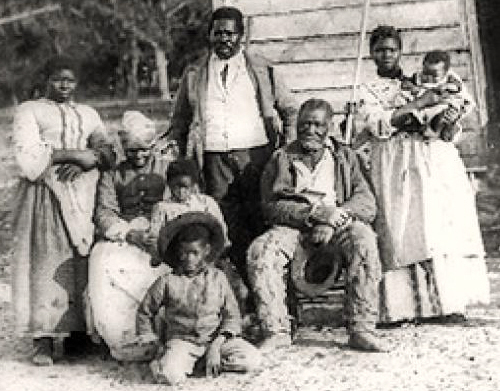 From 1664 and onwards, Barbadians played an important role in the early development of the United States of America. Sir John Colleton, a Barbadian planter, asked Charles 2nd of England to allocate land to him there, and he was given the section known as The Carolinas. Governor John Yeamans led a party of English colonists from Barbados to start the English colonies of the Carolinas in the U.S.A. Many left Barbados to settle the Carolinas, and most of the early governors were Barbadians. These British slave traders in the South of America operated out of Charles Town renamed Charleston, a city founded by them in South Carolina. They immediately started slave raids on the Westo and Stono tribes, engaging in the thriving business of selling enslaved Native Americans, who were forced to journey by foot from the remote regions where they were captured, to the waiting ships for exportation to Barbados, Antigua, and other ports in the Atlantic regions for sale, where they would spend the rest of their lives as slaves working for the European colonists. The captives were sold or traded in Barbados at great financial profit, with local whites taking the women as wives and concubines, while they traded the men for Afrikan slaves. Above were some of the Barbadians who settled the Carolinas.
From 1664 and onwards, Barbadians played an important role in the early development of the United States of America. Sir John Colleton, a Barbadian planter, asked Charles 2nd of England to allocate land to him there, and he was given the section known as The Carolinas. Governor John Yeamans led a party of English colonists from Barbados to start the English colonies of the Carolinas in the U.S.A. Many left Barbados to settle the Carolinas, and most of the early governors were Barbadians. These British slave traders in the South of America operated out of Charles Town renamed Charleston, a city founded by them in South Carolina. They immediately started slave raids on the Westo and Stono tribes, engaging in the thriving business of selling enslaved Native Americans, who were forced to journey by foot from the remote regions where they were captured, to the waiting ships for exportation to Barbados, Antigua, and other ports in the Atlantic regions for sale, where they would spend the rest of their lives as slaves working for the European colonists. The captives were sold or traded in Barbados at great financial profit, with local whites taking the women as wives and concubines, while they traded the men for Afrikan slaves. Above were some of the Barbadians who settled the Carolinas.
The imprint left can still be seen today through the identical names of the parishes and streets, the single house style of abode which was based on early Barbadian designs, and the Gullah dialect which is a mixture of West Afrikan languages and old English that goes back to the days of slavery, which is also similar to the Barbadian (Bajan) dialect.
Around 1671, the Barbadian-English settlers of the Carolinas began enslaving the Kusso Tribe and exporting them for sale in Barbados, where their mixed race children were logged as "white" when they were baptised, eliminating any paper trail for any present day white Barbadian to track down his/her unknown Amerindian ancestry.
In the United States, the Igbo slaves were known for their rebellious nature, and were numerous in the Maryland and Virginia states, while in states like Georgia there was a high suicide rate among the Igbos.
Afrikans shipped to the United States represented almost 4% or about 388,000 of the total number of Afrikans transported to the New World. This was substantially lower than the number shipped to territories in the Caribbean (West Indies), which included over 1.2 million to Jamaica, and 4.8 million to Brazil. Of those Afrikans who arrived in the United States, nearly half came from the Senegambia region.
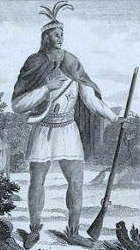 Captain Peter Wroth sailed from Barbados on his ship the Savoy for the Dutch Guiana coastline in South America in 1674 with a legal order from the Barbados English Governor Lord Willoughby and his successor Sir Peter Colleton, “to capture Arawak Indians for sale in Barbados”.
Captain Peter Wroth sailed from Barbados on his ship the Savoy for the Dutch Guiana coastline in South America in 1674 with a legal order from the Barbados English Governor Lord Willoughby and his successor Sir Peter Colleton, “to capture Arawak Indians for sale in Barbados”.
A year later, 160 Wampanoag Indians were captured in the U.S.A. and sent to Barbados to be sold and traded for Afrikan slaves. Among these 160 Wampanoags was a distinguished Chief Metacomet also known as King Philip (left), along with his wife Nanuskooke and their only son of 9 years, who were all sold into slavery in Barbados for one pound sterling each to a local English planter. In all, there were 900 Wampanoag Indians that were sold as slaves in Barbados. The Spanish Governor of Florida in 1682 recorded that “The English of South Carolina were capturing Native Florida Indians from the Spanish missions to be sold as slaves in the island of Barbados”. Early plantation deeds in Barbados confirm that Amerindian slaves with Spanish names were arriving in Barbados during that period.
In 1672, Tobago was captured from the Dutch by Barbadians under the command of Sir Tobias Bridges, and in 1689 a regiment of Barbadians under the command of Sir Timothy Thornhill was sent to assist the King’s troops against the French in the Leeward Islands, which proved to be notably victorious.
In 1691, the first law relating solely to slavery was passed, and remained in operation for about 20 years. The Assembly passed an all-inclusive law for slaves, and the majority of the terminology was adopted from the Barbados Slave Code of 1688. The South Carolina code described any Negro, Mulatto or Indian who had been bought or sold was to be labelled a slave, and this classification was also to be extended to the offspring of these slaves.
A statement printed in 1707 by Governor John Archdale in London, reported that Yammasee Indians who were under English Governance in the American Colonies were being “kidnapped by Spanish raiders who sold them as slaves to Barbados as was usual”. During 1708 Native Americans of the Ute Tribe from distant Illinois were being seized and transported to Barbados for sale by the English settlers of the Carolinas.
In 1739, the Barbados Parliament authorized legislation that allowed slaves to give evidence against the three categories of non-white people living in Barbados, freed Negroes, Amerindians, and Mulattos - who were accepted as mixtures of white and Negro, white and Amerindian or Negro and Amerindian.

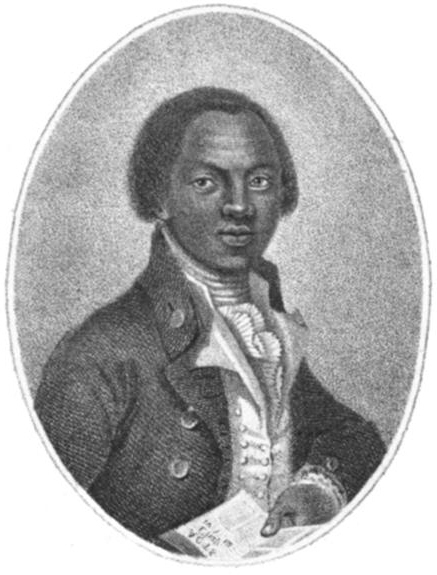 Between 1751 and 1775 Igbos were being dispatched to Barbados in large numbers, with 44 percent of the 90,000 Afrikans were predominately of Igbo origin who disembarked on the island from the Bight of Biafra The link between Barbados and the Bight of Biafra was established during the mid-seventeenth century with half of the Afrikan captives coming from there. Olaudah Equiano, (right), a famous Igbo author, abolitionist and ex-slave, was kidnapped from his homeland near the Bight of Biafra and shipped to Barbados. After spending a short period of time in Barbados, Equiano was shipped to Virginia and put to work weeding grass and gathering stones.
Between 1751 and 1775 Igbos were being dispatched to Barbados in large numbers, with 44 percent of the 90,000 Afrikans were predominately of Igbo origin who disembarked on the island from the Bight of Biafra The link between Barbados and the Bight of Biafra was established during the mid-seventeenth century with half of the Afrikan captives coming from there. Olaudah Equiano, (right), a famous Igbo author, abolitionist and ex-slave, was kidnapped from his homeland near the Bight of Biafra and shipped to Barbados. After spending a short period of time in Barbados, Equiano was shipped to Virginia and put to work weeding grass and gathering stones.
Strong elements of the Igbo culture can still be found in Barbados. For example, in the Barbadian (Bajan) Dialect, the Igbo word “unu”, which became “wunna”, translates into English as "you people" and is commonly heard everywhere. Barbadians refer to their island informally as "Bim", which is a colloquial term that was used among the enslaved Barbadians. This word was derived from bé mụ́ in the Igbo language which means "my place or my people". This title may have arisen because of the huge percentage of enslaved Igbo people from Nigeria who arrived in Barbados during the 18th century.
Other common words like Obeah from Igbo Obia meaning "doctoring, mysticism, occultism, or oracle", and de, deh from Igbo dị̀ meaning "present in" are still used. The Twi word Adope became duppy (ghost/spirit).
Barbadian (Bajan) dialect is a mixture of Igbo, Fulani, Manjaku, Susu, a bit of Twi, some Efik, some Ga Dangme and other Afrikan languages, however, the dialect has a very strong Igbo Influence.
The majority of documents on slavery usually state that the Negro slaves called their owners "Massa", suggesting they were speaking broken English, but this was just another myth to hide the true identity of the Afrikan lineage. These Israelite slaves spoke a pure language, that is, Hebrew, so when addressing the slave owners and overseers and they said, "Yes Massa or No Massa", it seemed that their accents did not allow them to pronounce "Master" clearly.
However, Massa is a Hebrew word which means "burden" or "oppressor" and is defined in Strong’s number 4853 which can also be found in various passages of the Hebrew Old Testament. Therefore when the slaves responded to the slave owners and overseers with "Yes Massa or No Massa," they were actually saying "Yes oppressor or No oppressor", so it was not a case of the slaves mispronouncing the word "Master" which they could clearly articulate, but they were referring to the slave masters as "Massa" because they saw them as "a burden, an oppressor".
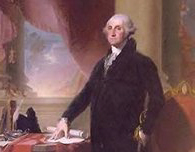 In 1751, George Washington, then 19 years old, came to Barbados with his brother Lawrence to recuperate from tuberculosis. It was his only trip outside the U.S.A., but while in Barbados, he contracted smallpox. Provided with excellent care, he quickly recovered and his body built up a natural immunity to the virus. This became important later when his army was decimated by smallpox during the American war of independence, but the immune Washington was not affected and survived to win the war, later becoming the first president of the U.S.A.
In 1751, George Washington, then 19 years old, came to Barbados with his brother Lawrence to recuperate from tuberculosis. It was his only trip outside the U.S.A., but while in Barbados, he contracted smallpox. Provided with excellent care, he quickly recovered and his body built up a natural immunity to the virus. This became important later when his army was decimated by smallpox during the American war of independence, but the immune Washington was not affected and survived to win the war, later becoming the first president of the U.S.A.
Between 1800 and 1885 Barbados served as the main seat of Government for the former British colonies of the Windward Islands, and the resident Governor of Barbados also served as the Colonial head. After the Government of Barbados officially withdrew from the Windward Islands union in 1885, the seat was moved to St. George's, Grenada. When Barbados exited from the Windward Islands, it became aware that Tobago was going to be united with another territory to form a single state, so Barbados made an official bid to the British Government to have the neighbouring Island of Tobago grouped with Barbados to establish a political union. However the British government decided that Trinidad would be a better alternative, thus making Tobago a Ward of Trinidad instead.
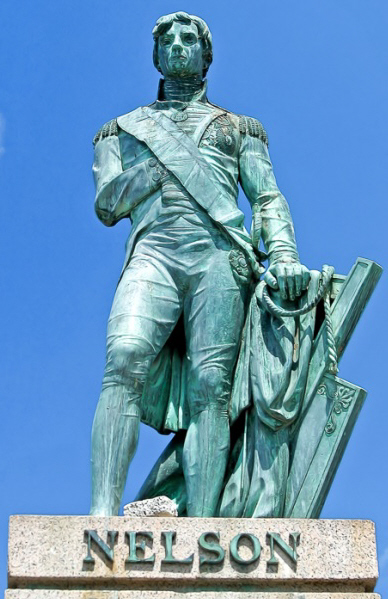 In 1803 war broke out with the Spanish and French combining forces against Britain. At this time Barbados was tactfully used to retake the Islands held by the French. Admiral Nelson was a key figure who was aware of his duty as defender of the important regions of the British Empire. In 1805, he wrote to Lord Seaforth, the Governor of Barbados, "Your Lordship may rely that everything in my power shall be done to preserve the colonies".
In 1803 war broke out with the Spanish and French combining forces against Britain. At this time Barbados was tactfully used to retake the Islands held by the French. Admiral Nelson was a key figure who was aware of his duty as defender of the important regions of the British Empire. In 1805, he wrote to Lord Seaforth, the Governor of Barbados, "Your Lordship may rely that everything in my power shall be done to preserve the colonies".
After the unexpected declaration of the Trafalgar victory, a fund was established when news of his demise reached the island, and £2,500 was raised within a few weeks after which “The Green” in the centre of Bridgetown was purchased for £1,050 and renamed Trafalgar Square. In 1813 a bronze statue of Nelson in admiral’s uniform was erected by the Barbadians to honour Lord Nelson, the victor of Trafalgar.

Barbadian planters recognised that the island had an increasing slave population that would guarantee continuous sugar production, while the other regions such as the newly occupied territories like Trinidad, Essequibo, Demerara and Berbice (Guyana), would be hampered in their economic development if access to slave labour was denied.
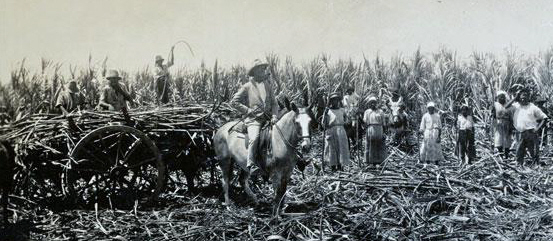 The colony had its own share of problems which included raids by Spanish and French pirates, in addition to chaotic weather that decimated crops and triggered Afrikan and Irish slave revolts. These revolts often coincided with the raids and uncontrollable weather which distracted the slave owners, who would send slaves to other settlers or towns for help. The freedom to move around gave slaves the opportunity to convey information to other revolutionaries. These rebellions increased the fear of white slave owners.
The colony had its own share of problems which included raids by Spanish and French pirates, in addition to chaotic weather that decimated crops and triggered Afrikan and Irish slave revolts. These revolts often coincided with the raids and uncontrollable weather which distracted the slave owners, who would send slaves to other settlers or towns for help. The freedom to move around gave slaves the opportunity to convey information to other revolutionaries. These rebellions increased the fear of white slave owners.
As a result, Barbadian law banned slaves during the mid-eighteenth century from leaving their plantations without permission from their owners, and also prevented them from beating drums, blowing horns, or playing other loud instruments, because this was seen as a medium that allowed those slaves who spoke different languages to be able to communicate with each other. Other authorized restrictions broadened this objective by outlawing parties on Sundays, which was the Christian day of rest.
Afrikan music was used in the Afrikan religion called Obeah which was prevalent all over Barbados. The Church of England sent missionaries to convert the slave populations to Christianity, and any noticeable ethnic trait of Afrikan origin was suppressed in the name of spreading this new religion. Barbados passed its own adaptation of the Fugitive Slave Law, which required all whites to return runaway slaves to colonial officials. This law was however relaxed when it came to a slave master who deliberately killed a slave, requiring him to pay only a $15 fine, but those who killed their slaves "accidentally" usually escaped without being fined.
The Barbados slave codes became the model on which every other British Caribbean colony in the West Indies was patterned, including Jamaica and Antigua who passed identical laws in 1664 and 1702. These promoted harsh slave laws, gang labour for Afrikans with a 12 hour work day, and barbaric punishment for violations of the slave laws.

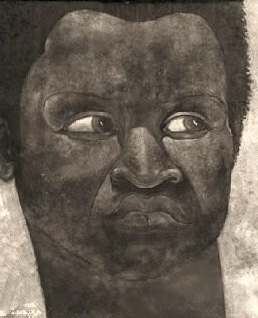 In 1807 the British parliament had abolished the slave trade, but emancipation was not as forth- coming as the slaves in Barbados were expecting. This led to a major rebellion in 1816 headed by "Bussa", a Barbadian slave revolt leader of Igbo lineage, who was born in Nigeria. He was abducted and sold by the English to Barbados during the late 18th Century. Bussa was able to strike a deep blow for freedom after leading Barbados' longest slave revolt against the racist and oppressive white Barbadian planters on April 14, 1816. The island-wide conspiracy was an attempt to change the society to a Black image and to gain freedom by ousting the reigning planter class.
In 1807 the British parliament had abolished the slave trade, but emancipation was not as forth- coming as the slaves in Barbados were expecting. This led to a major rebellion in 1816 headed by "Bussa", a Barbadian slave revolt leader of Igbo lineage, who was born in Nigeria. He was abducted and sold by the English to Barbados during the late 18th Century. Bussa was able to strike a deep blow for freedom after leading Barbados' longest slave revolt against the racist and oppressive white Barbadian planters on April 14, 1816. The island-wide conspiracy was an attempt to change the society to a Black image and to gain freedom by ousting the reigning planter class.
This carefully planned Rebellion by Bussa and his confederates of about 3,900 to 5,000 elite rebel slaves on a number of Barbadian sugar estates was the first slave insurrection in Barbados in 124 years. This famous freedom fighter, along with King Wiltshire Bailey, led the slaves into battle at Bayley's Plantation where Bussa was a head ranger. 400 freedom fighters along with other enslaved Maroons who were predominately Igbo, were led into battle against the troops of the First West India Regiment. They were able to communicate with each other using their native languages, beating drums, and practicing their indigenous Afrikan Spirituality.
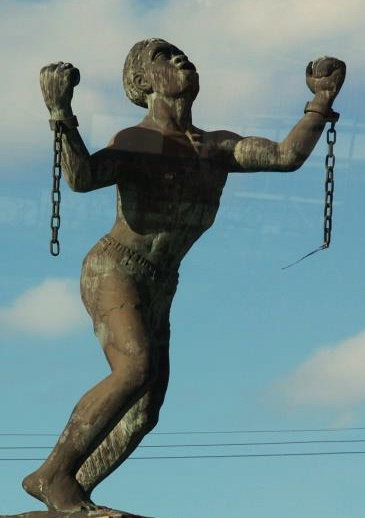 However, a premature launch of the revolt allowed the white population to gain the upper hand, otherwise large portions of the island would have gone to the rebels.
Bussa was killed in battle but his troops continued the fight until they were eventually defeated by a superior fire power. The official figures stated that 214 slaves were executed and 123 transported, but the actual death figures were said to be more in the region of 1,000 slaves killed and executed. Captured rebels confessed that exploitation was not the reason for their rebellion but that the island belonged to them so they were going to kill every white man living on it.
However, a premature launch of the revolt allowed the white population to gain the upper hand, otherwise large portions of the island would have gone to the rebels.
Bussa was killed in battle but his troops continued the fight until they were eventually defeated by a superior fire power. The official figures stated that 214 slaves were executed and 123 transported, but the actual death figures were said to be more in the region of 1,000 slaves killed and executed. Captured rebels confessed that exploitation was not the reason for their rebellion but that the island belonged to them so they were going to kill every white man living on it.
The Bussa rebellion was the largest slave uprising, and his name lived on for generations in the memory of Barbadians. An Emancipation Statue was unveiled in Bussa's honour 169 years after that rebellion. Emancipation Day is celebrated on August 1st to mark the abolition of Slavery in Barbados, which dates back to the Slave uprising of 1816 on the Island.
As a result of that revolt, and determined to prevent any future insurrections, officials in London insisted that the colonists should put reforms in place to reduce the burdens of slavery. This course of action was met with intense opposition from the Barbadian planters, but the policy was eventually approved by the Barbados legislature.
Barbados was allowed to adopt its own slave registry laws making it possible to abolish slave laws from the Barbadian legislature. The Consolidated Slave Law of 1825 established three rights for slaves:
- The right to own property;
- The right to give evidence in all court cases; and
- A reduction in the rates charged to prevent white slaveholders from freeing their slaves.
Because of the heroic efforts of Thomas Clarkson, Granville Sharp and William Wilberforce, the slave trade was abolished in 1807. This took place a few years before the abolition of slavery throughout the British Empire in 1834, when the slaves in Barbados became free citizens 29 years before its abolition in the U.S.A.
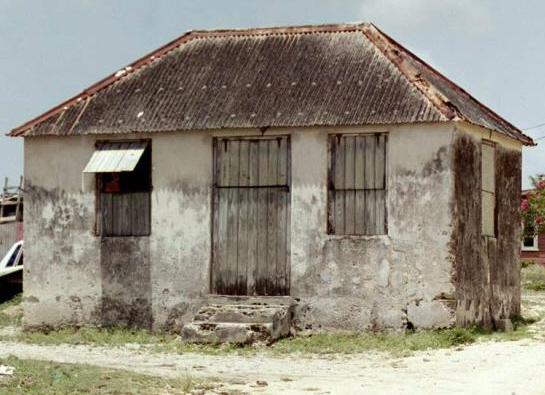 However, a 4 year apprenticeship programme was set up where the freed men had to work a 45 hour week without pay in exchange for living in the tiny huts provided by the plantation owners, (right) until the end of the apprentice period on August 1st, 1838. By then the kidnapped Irish had disappeared into history and the census of the 1880's did not identify any Barbadians as Irish. Only a small population of poor whites called "red legs" who were the descendants of those "barbadosed" Irish, remained.
However, a 4 year apprenticeship programme was set up where the freed men had to work a 45 hour week without pay in exchange for living in the tiny huts provided by the plantation owners, (right) until the end of the apprentice period on August 1st, 1838. By then the kidnapped Irish had disappeared into history and the census of the 1880's did not identify any Barbadians as Irish. Only a small population of poor whites called "red legs" who were the descendants of those "barbadosed" Irish, remained.
In celebrating the end of the apprenticeship period, over 70,000 Barbadians of Afrikan decent took to the streets with the Barbados folk song:
"Lick an Lock-up Done Wid, Hurray fuh Jin-Jin (Queen Victoria).
De Queen come from England to set we free
Now Lick an Lock-up Done Wid, Hurray fuh Jin-Jin."
 During the days of slavery and immediate post emancipation, the more entrepreneurial people established small shops where rum, other spirits and a variety of goods were sold.
These shops also functioned as a meeting place for discussions and playing games, which helped to strengthen the community spirit.
During the days of slavery and immediate post emancipation, the more entrepreneurial people established small shops where rum, other spirits and a variety of goods were sold.
These shops also functioned as a meeting place for discussions and playing games, which helped to strengthen the community spirit.
A popular game brought to Barbados with Afrikan roots was Warri, also known as Oware and Ampe, which originated in the West Afrikan countries like Ghana, Nigeria, Togo, Benin, and other similar Afrikan locations.
Coucou which is Fufu, originated in West Afrika and is the local Barbadian dish.
Kwaku Ananse folk stories were also brought to and told in Barbados, other parts of the Caribbean, and in the Americas during Slave Trade era.
During the 1930s, a movement for political rights was initiated by the descendants of emancipated slaves. One of the leaders of this movement was Sir Grantley Adams who, in 1938, founded The Barbados Progressive League, now The Barbados Labour Party. By 1944 civil rights were given to women, and in 1951 the right to vote by all adults was allowed. On November 30th 1966, Barbados gained its independence from Britain under the leadership of the late Sir Errol Walton Barrow.

 Barbadian (Bajan) culture and music evolved from the fusion of Afrikan, European and Caribbean components. The earliest mention of Afrikan-Barbadian music came from a description of a slave revolt where the rebels were inspired by the music played on skin drums, conch trumpets and animal horns to engage in battle. As a result, the English colonist and slave owning authorities banned musical instruments among slaves, because they suspected that their drumming skills could be used to send secret messages to organize and launch rebellions against them. Therefore, in 1688 a law was passed that outlawed the playing of drums and other "heathenous noises" on the plantation or in the town. Death was one of the penalties, but the slaves got around this law to some extent by adjusting their Afrikan derived rhythms to sound more European.
Barbadian (Bajan) culture and music evolved from the fusion of Afrikan, European and Caribbean components. The earliest mention of Afrikan-Barbadian music came from a description of a slave revolt where the rebels were inspired by the music played on skin drums, conch trumpets and animal horns to engage in battle. As a result, the English colonist and slave owning authorities banned musical instruments among slaves, because they suspected that their drumming skills could be used to send secret messages to organize and launch rebellions against them. Therefore, in 1688 a law was passed that outlawed the playing of drums and other "heathenous noises" on the plantation or in the town. Death was one of the penalties, but the slaves got around this law to some extent by adjusting their Afrikan derived rhythms to sound more European.
Early Barbadian folk music among the slaves was "essential for recreation and dancing and as a part of the life cycle for communication and religious meaning". Afrikan musicians also provided the music for the white landowners' private parties, while developing their own brand of party music. This resulted in the world renowned Crop Over Festival which started around 1688. Early Crop Over festivals featured dancing and call-and-response singing accompanied by shak-shak, banjo, bones and bottles which contained varying amounts of water to produce different notes. By the end of the 17th century, a distinctly Barbadian folk culture had emerged.
Barbadian traditional folk songs narrated current events at the time they were written, such as the emancipation of the Barbadian slaves, or the coronations of Victoria, George the 5th , and Elizabeth the 2nd. This singing tradition dates back to 1650. Some Barbadian songs and stories such as the famous "Inckle the English Sailor" and "Yarico the Indian Maid" made their way back to England and became English plays and an opera by George Coleman, with music by Samuel Arnold. They were first performed in London in 1787.

Tuk bands are Barbadian musical groups that consist of a double-headed bass drum, kettle drum, bow-fiddle or penny whistle, a tin flute, a kittle triangle and a snare, which all combine to create a distinct Barbadian fusion of Afrikan and Bajan rhythms. The kittle and bass drum provide the rhythm, while the flute provides the melody. The drums are made from cured sheep and goat skins, making them light in weight and easy to carry around.
Tuk bands usually performed at special occasions such as visiting royalty and coronations, and are generally accompanied by a range of symbolic characters such as "Shaggy Bears", "The Green Mother Sally" which represents female fertility, "The Steel Donkey", "Green Monkeys", "The Stilt-men" which represent surviving hard times, and other traditions which are symbolic of the ceremonial healers from Afrikan villages. Masquerades are of Igbo origin, and the costumes are of West Afrikan origin. Similarly structured bands can still be seen today in Ghana and Nigeria.

 Spouge, a fusion of Jamaican Ska and Banja, was once the popular Barbadian form of music which was created by the late Jackie Opel (left) in the 1960s. Banja was a term used prior to the 1930s when Bajan calypso was called Banja. Spouge instrumentation consisted originally of a cowbell, bass guitar, trap set and various other electronic and percussion instruments, later boosted by the saxophone, trombone and trumpets.
Spouge, a fusion of Jamaican Ska and Banja, was once the popular Barbadian form of music which was created by the late Jackie Opel (left) in the 1960s. Banja was a term used prior to the 1930s when Bajan calypso was called Banja. Spouge instrumentation consisted originally of a cowbell, bass guitar, trap set and various other electronic and percussion instruments, later boosted by the saxophone, trombone and trumpets.
The cowbell and the rhythm guitar are generally considered to be the most essential part of the instrumentation that reflected the Afrikan origin of this indigenous musical creation.

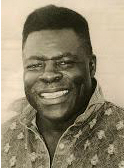 During the 1960s, two different types of Spouge rhythms were popular: Raw Spouge popularised by The Draytons Two, (left) and Dragon Spouge popularised by Barbadian Cassius Clay (right). The Spouge industry grew considerably by the end of the 1970s before suddenly vanishing from the local music scene. There was a renewal of interest in Spouge music in some quarters in recent years, with artistes like Desmond Weekes of The Draytons Two suggesting that Spouge should be encouraged because of its national format and potential to awaken the pride of the nation, not to mention its ability to reach worldwide audiences.
During the 1960s, two different types of Spouge rhythms were popular: Raw Spouge popularised by The Draytons Two, (left) and Dragon Spouge popularised by Barbadian Cassius Clay (right). The Spouge industry grew considerably by the end of the 1970s before suddenly vanishing from the local music scene. There was a renewal of interest in Spouge music in some quarters in recent years, with artistes like Desmond Weekes of The Draytons Two suggesting that Spouge should be encouraged because of its national format and potential to awaken the pride of the nation, not to mention its ability to reach worldwide audiences.

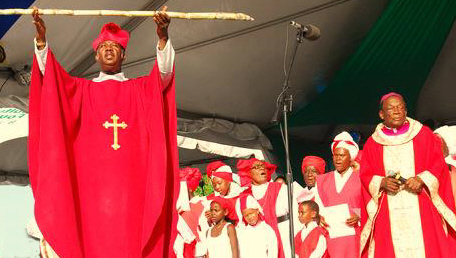 Obeah was practiced in Barbados and other Caribbean nations. In some cases, the Christian religion embraced strong elements of Obeah as part of the faith.
Obeah was practiced in Barbados and other Caribbean nations. In some cases, the Christian religion embraced strong elements of Obeah as part of the faith.
The Spiritual Baptist Church for example, consists of an Afrikan-Caribbean integrated religion that blends elements of traditional West Afrikan religion with Christianity. However, despite the heavy Afrikan influences and ritual practices, Spiritual Baptists look upon themselves solely as Christians.
Obeah, sometimes written Obi, is an expression used in the Caribbean when referring to folk magic, sorcery or religious practices that originated in Central and West Afrika from the beliefs of the Yoruba tribe, like Voodoo, Santeria and the Orisha belief systems. The West Afrikan Ashanti used the term Obi or Obeah to describe the practices of the slaves of Central Afrikan lineage. The practitioners of the Congo form of folk religion were called Obeah men or sorcerers. An Obeah man is also called a medicine man, root doctor, sorcerer, or voodoo witch-doctor. Obeah is therefore associated with black and white magic, charms, fetishes, luck and mysticism in general, which is similar in nature to Voodoo, Santeria, Rootwork/ Hoodoo, and Palo.
Obeah is characterized by the use of magic rituals for protection against bad luck or to cause harm, and is a practice which uses the power of duppies (spirits) to manipulate human events. Spiritualism or contact with the dead is a basic component of many Afrikan religions. Obeah may also refer to any solid object such as a talisman or charm that can be used for evil magical purposes. In spite of its negative reputation however, Obeah, like any other form of folk religion, folk medicine and folk magic, contains many rituals for healing, attracting money, bringing about luck in love, controlling wandering partners, and even eliminating the difficult problems of life.
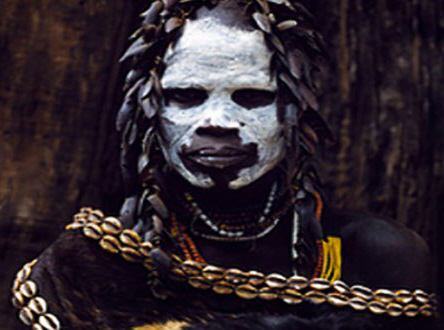 The Afrikan slaves used these supernatural rituals brought with them from their various Afrikan homelands as a means of protecting themselves against the domination of the white enslavers.
The Afrikan slaves used these supernatural rituals brought with them from their various Afrikan homelands as a means of protecting themselves against the domination of the white enslavers.
Conflicts arose when slaves from different regions of Afrika who practiced diverse styles of Afrikan religion and spoke different languages came into contact with each other, but out of this interaction the common term Obeah was popularised.
A number of Afrikan languages contain words that have contributed to the term Obeah.
The Igbo word Obia means doctoring, mysticism, or oracle. Another Igbo word díbìà means folk healer.
The Efik word ubio means bad omen; any harmful object; or a charm buried in the ground to cause sickness or death.
The Twi word obayi means magic or sorcery.
The Twi word obayi means magic or sorcery.
The Ashanti word obayifo means a wizard or witch. Another Ashanti word Obi means sorcery, and also refers to the West Afrikan snake god, spirit of evil, which involves animal sacrifices.
The Egyptian word Obion (Ob) or Aub means serpent. Oph is a winged serpent or dragon; and Ab means wisdom. They signify Serpent of Wisdom or Serpent of Knowledge when combined.
Obeah can therefore be defined as a source of occult power: a strong medium used to give power to induce spells for practical magic, witchcraft and other forms; to predict the future; to communicate with the gods; or to gain support or knowledge from planes beyond the physical realm. These actions are accomplished through the skills of the Obeah practitioner and go beyond the tenets of traditional witchcraft, sorcery, shamanism, voodoo or tribal magic.
In the domain of the occult practitioners where mystics, tribal elders, shamans, wizards, sorcerers, spell-casters, diviners, necromancers, witches and other sources of occult power operate in other dimensions, the most powerful, the most dreaded, the most feared is Obeah.
Obeah today is blended with the worship of Orisha, which are spirits of nature and powerful ancestors who are prayed to and sometimes allowed to take possession of the practitioners.
The first image shows a Barbados Penny which was minted during the reign of King George III in 1788.
The second image shows another Barbados Penny issued in Barbados around 1792 with King George III of England on one side, and Neptune riding a horse and chariot on the other side. Note the spellings of Barbados.

© John Moore - Barbados, W.I. (March 2000)©. All rights reserved.